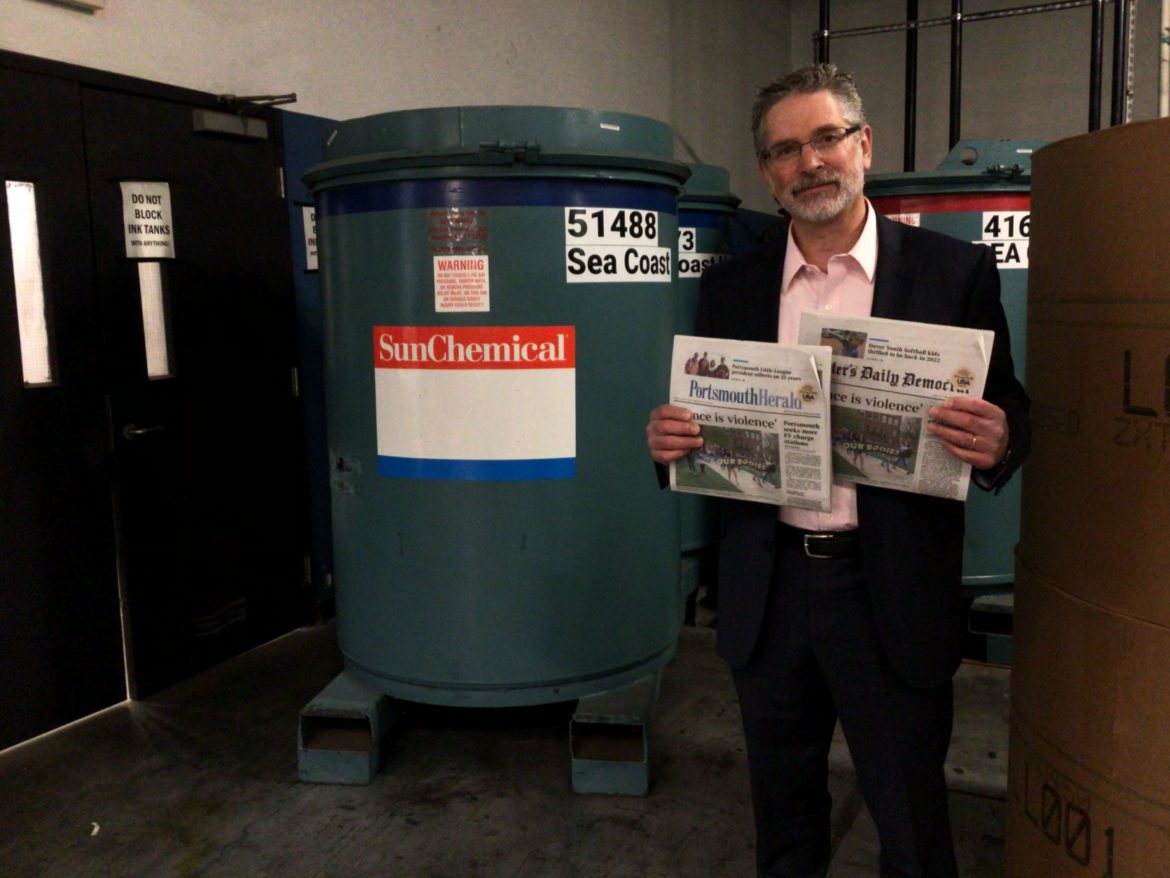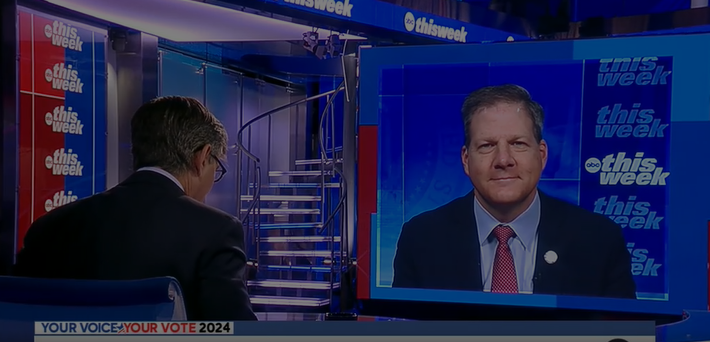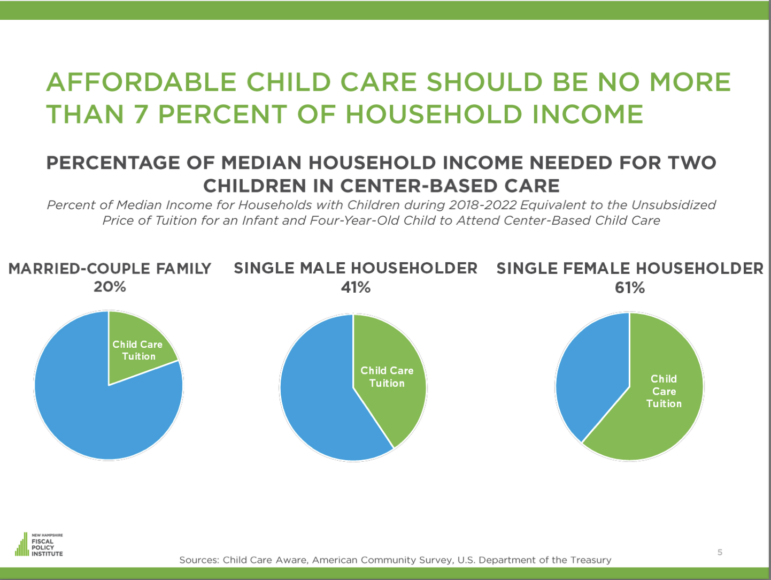Among the Latest Cost-Cutting Moves: Portsmouth Herald and Foster’s Daily Democrat Go Digital on Saturdays
By Terry Farish, InDepthNH.org
Nationally, U.S. weekday newspaper circulation is down over 19 million readers during the past decade, according to Pew Research numbers, and newspaper newsroom employment fell 57 percent between 2008 and 2020, from roughly 71,000 jobs to about 31,000.
The numbers paint a bleak picture of the U.S. newspaper industry as a whole, but here in New Hampshire, publishers are more optimistic that the print industry can keep itself alive, and they are being creative in their efforts to regain their footing.
Pew reported that U.S. weekday newspaper circulation stood at 43.4 million just a decade ago. In 2020, weekday circulation of U.S. newspapers — print and digital combined — was 24.3 million.
U.S. newspaper revenue has declined dramatically since 2008, climaxing in pandemic-imposed economic losses.
Will newspaper newsrooms soon go away?
“Journalism is not dying,” said Concord Monitor Publisher Steve Leone. “It’s in need of a different model. Journalism needs to succeed in all its forms. Not one form. We need to support each other and hold each other accountable.”
Two daily New Hampshire newspapers owned by the corporate media giant Gannett have moved to a model of six days of print and one day digital-only. The Portsmouth Herald and Foster’s Daily Democrat ceased publishing their Saturday papers in print as of March 5 and now publish digital-only Saturday papers. The remaining days of the week include print editions.
While this increases the digital-only presence for the two Seacoast papers, the move to digital overall has actually developed more slowly than some have predicted. According to Pew Research, eight in 10 Americans get their news from digital devices.
Howard Altschiller is the executive editor of Seacoast Media Group, the only Gannett-owned papers in the state, which in addition to the Portsmouth Herald and Foster’s, also owns four weekly print publications: the Exeter News-Letter, Hampton Union, the York Weekly and the York County Coast Star.
“Gannett is news focused. Reader focused,” Altschiller said. “We are among the fastest-growing sites of Gannett’s250-plus sites nationwide. We’re also off to a remarkably strong start in 2022 in new digital subscriber volume.”
How could this be?
“We shake our heads,” Altschiller said, laughing. Then he said, “We’ve got the right content. Anything we print on land use, development, business, housing, anything about restaurants. That’s what readers want.” Altschiller says he sees the narrative of the death of journalism, but, he said, “I just don’t see it here and I’m in the trenches.”
With Gannett, he said, “It’s easier to communicate with my team. We have the analytics and our reporters are doing those stories they know people want.”
Altschiller said he’s not at liberty to disclose the number of subscribers, number of newsroom staff, or comparison circulation numbers, but that Gannett can be queried.
Gannett responded to a request for numbers in an e-mail: “We do not disclose personnel data, including numbers of full-time employees by site, or share subscription data at the market level.” When queried about numbers they share with advertisers, Gannett didn’t respond.
Portsmouth Herald cost – Home delivery + digital, 6 days, $234/year; digital only, $143/year.
Dan Kennedy, Northeastern University professor of journalism and blogger at Media Nation, reported in February, “Gannett is up 46% over the past year, to 1.5 million paid digital subscriptions” for all the dailies it owns, including USA Today.
Some local readers are not impressed. They feel the loss of regular features they used to read in the Portsmouth Herald and experience irregularity in delivery of the print paper.
Deidre Randall, CEO of Peter E. Randall Publishers in Portsmouth, expresses the perception of a number of local readers, “Our newspaper lacks local writers and local coverage.”
According to Media Nation, Gannett owns 100 daily papers and 1,000 weeklies. Among their dailies is USA Today. Readers of the Portsmouth Herald see USA Today stories, regional stories, stories from the Associated Press, New Hampshire Bulletin, The Maine Monitor, and other publications.
Kennedy says, “A lot of closure in print is tied generally to Gannett. It’s hard to separate ceasing print from cuts in news staff [because there’s more regional as opposed to local coverage.]” Kennedy’s concern: “Who’s covering town meetings? School board meetings? Will they let that go? There’s more corruption without local news.”
Altschiller is quick to say that they’ve been able to make new hires of strong journalists when former journalists leave. He said they haven’t lost Portsmouth newsroom staff. He did say there are fewer freelancers. “Gannett prefers to have staff reporters.”
Across the state, newspaper publishers tell stories of hard choices, transitions, pain, and a variety of models for sustaining journalism. The thread through all the stories is digital.
Here are snapshots of six other New Hampshire newspapers:
Mark Guerringue, publisher of the Conway Daily Sun, prints the daily paper five times a week and gives it away free. He also publishes the Berlin Sun and co-founded the Laconia Sun with Adam Hirshan and Ed Engler. “All Local and All Free.” The Conway Daily Sun runs Tuesday – Saturday, with a print run of 15,000. In 2018, the Conway Daily Sun won First Place for General Excellence in the daily newspaper category in New Hampshire Press Association’s Distinguished Journalism contest. Currently, they have seven on the newsroom staff (reporters, photographers, editors.)
Three months ago, the Conway Daily Sun began a digital service and, reversing the traditional model, continue to offer the print paper free but charge for the digital edition. “We were internet ready,” Guerringue says. They call it a membership and charge $69. “People have said, ‘Why would I pay when I can pick up a free one?’ “Good,” he tells them. “We just want you to read the paper.” Meaning, he seeks to keep providing local news and cultivating a readership who trusts it.
The Conway Daily Sun adds content to the digital paper to make it more appealing and now has 1,200 paid subscriptions. They lost advertising revenue when the big chain stores were shutting down. Revenue was down 25% and the cost of newsprint was going up.
“Print is dying,” Guerringue said. “We just don’t know precisely when. Hopefully we have a long enough runway [with the digital service].” There are no plans to stop the free paper.
Conway Daily Sun cost – free print paper 5 days; digital – $69/year.
The Telegraph of Nashua, owned by Ogden Newspapers in West Virginia, ceased printing a daily paper abruptly. In April 2020, they moved to publish digitally seven days a week and publish a weekend print Sunday Telegraph. Publisher Matt Burdette said the paper has 8,500 subscribers and is growing the digital readership. “The Telegraph was the first in the northern states to use the model of a digital daily and a printed weekend edition.” Burdette had worked in West Virginia for 25 years before coming to Nashua and says, “We’re fortunate here to have many veteran journalists on staff.”
“The newsroom is smaller now,” he said. “We have five full-time news staff and nine freelancers, writing columns or news.” They use InDepthNH.org for statehouse coverage. “In the old days we had a statehouse reporter but the economics changed. We heavily promote the print edition. There’s more footwork to get the ads.” But they’re working to show the value of digital advertising.
Telegraph cost – Home delivery 1 weekend edition and 7 days digital, $156/year
President and publisher of the New Hampshire Union Leader, Brendan McQuaid, says the worldwide economic instability has impacted the supply and cost of newsprint and hurt all newspapers. “There’s been a 50% increase in the cost of printing over the last year.” He said, “A couple years ago the Union Leader moved to six days of print and a digital Saturday edition.” But that’s as far as they want to go toward digitalization at this point. “It’s a gray state,” he said, indicating that this readership prefers print. Circulation for the daily is in the low 20,000s and for the Sunday, 40,000 to 50,000.
The newsroom staff is “in the high teens.” But he said, “Everyone wishes they could have more.”
“We’re in a building that’s 170,000 square feet. We used to use it all. We had mainframes, newsprint storage, presses, mailroom.” But now they don’t have a print shop; they print in Penacook at the Concord Monitor’s press. The Union Leader uses 10% of the enormous building they’re in. So they sold the building, and rent their 10%. McQuaid said, “When the pandemic came, we were already pretty lean.”
Union Leader cost – Home delivery + digital, 6 days, $345; digital only, $191
Valley News in the Upper Valley, circulation 10,500, is “100% print, seven days a week,” says publisher Dan McClory. They offer a digital replica with 2,220 digital-only subscribers. A strategy Valley News is using is partnering with Report for America which, according to the Report for America site, is “a national service program that places talented emerging journalists in local newsrooms to report on under-covered issues and communities.” The program funds 50% of the reporter’s salary for one year and continues to provide support the second year, though a decreasing percentage. The Valley News RFA reporters focus on specific beats, climate/environment and education. “We are taking baby steps to fund part of the newsroom through community funding,” McClory said. They have a newsroom staff of sixteen including the two Report for American reporters. A goal is to develop community partnerships to fund these reporting positions in a permanent way.
Valley News is a Newspapers of New England paper, a corporate owner of a total of nine newspapers, both dailies and weeklies. Their holdings include two other New Hampshire papers, the Monadnock Ledger-Transcript in Peterborough and the Concord Monitor.
Valley News and all the papers suffered losses during Covid-19 shutdowns. On March 24, 2020, McClory wrote to readers. “In the newsroom, we’ll have less staff as we begin producing some news pages in coordination with the Concord Monitor, our sister publication in Concord.” He wrote, “Please keep the kind words coming and help us by supporting local journalism and local businesses.”
Today, he says, “Things have stabilized somewhat. We are entering our second year with Report for America and continue to explore different avenues for community funded journalism.”
Valley News cost – Home delivery + digital, 7 days, $260/year; digital only, $221/year.
The Concord Monitor also tapped into the resources of Report for America to build newsroom staff. The Monitor has two Report for America reporters, one on the health beat, the second on education, and a third RFA reporter will come in June to focus on Two New Hampshires, a beat about economic disparities. Publisher Steve Leone said the Monitor has partnered with local businesses and nonprofits including Concord Hospital and Riverbend Community Mental Health to help to fund the news. “We have terms of agreement [including such stipulations that] the partner has no influence on coverage.” The paper offers “Sponsored by…” pages with sponsors that include a health club and a masonry supply yard. They run spots from local businesses running for 2022 CAPPIES, best of community awards. They also list promotions, contests, sweepstakes, and giveaways.
“It’s not regular advertising. It’s motivated by outwardly supporting the community,” Leone said. “Every last dime goes to journalism.”
Daily print circulation is 10,000, and digital-only is 2,000. The Monitor prints at its own press in Penacook with other Newspapers of New Hampshire papers as well as the Union Leader. “Printing is a tough business,” Leone said. “It’s most connected to inflation. But we’ll continue to print until there is not a strong need.” Part of the path to digital publication, he believes, is to “show that what we’re doing digitally has the same authority as print.”
The Monitor’s cost – Home delivery + digital, 7 days, $286; digital only, $109.
The Keene Sentinel is a family-owned newspaper with a print and digital circulation of 4,000, digital-only, 1,700. In March, 2021, when subscriptions were declining or not sustained after the initial price, one step they took was to partner with a local coffee roaster. New subscribers received, by hand delivery, a pound of fine coffee and a newspaper.
Terrence Williams, Keene Sentinel President and COO, said, “It brought 400 new starts and 80% are still with us.” He said the promotion built goodwill and laid the way for many future partnerships with other local businesses. Their latest partnership is with Stuart and John’s Sugar House in Westmoreland. “Unlimited Digital Access. Subscribe and receive a FREE quart of maple syrup from Stuart & John’s!”
The Keene Sentinel does an annual crowdfunding effort. They ran a campaign to support a statehouse reporter. Now they are looking to Solutions Journalism, an organization that states on its site, “Our mission is to transform journalism so that all people have access to news that helps them envision and build a more equitable and sustainable world.” Solutions Journalism provides grants and training. With the support of Solutions Journalism, the Sentinel seeks to win a grant of about $5,000 to support a health reporting lab to report on quality health care for residents. Williams said they’ve applied for a Report for America reporter, but have not won a grant yet.
“We reinvest everything in the news,” Williams said. The Sentinel has its own press where they print the paper as well Keene State College’s award-winning student newspaper, The Equinox, and a number of newspapers in Vermont.
Keene Sentinel cost – Home delivery + digital, 6 days, $424; digital only, $169.
Not all journalists support the model of Report for America. Chris Faraone, Director of Editorial, Boston Institute for Nonprofit Journalism, said, “I’m not a fan. Does Report for America bring sustainability to a newsroom? No.” He refers to the fact that they offer short-term support. “We have to take any tools we can get, but newsrooms need more.”
Report for America’s largest funder is the Meta Journalism Project (formerly the Facebook Journalism Project). Other funders are the Google News Initiative along with many smaller funders including the Corporation for Public Broadcasting and local newsroom supporters.
Sam Kille, Director of Communications for Report for American said by e-mail that the budget for Report for America in 2021 was $8.3 million. Broken down, 93% went toward program costs, 5% to administrative, and 2% to fundraising.” Report for American is a part of the organization, The GroundTruth Project.
Funding for Report for America by Meta and Google was a key topic at the International Journalism Festival in April as reported in the Columbia Journalism Review. The Review reported that many conference panels addressed “the implications of Meta (formerly Facebook) and Google being the largest global funders of journalism and whether media organizations should accept funding from platforms at all.”
Solutions Journalism provides grant funding for reporting projects, and Chris Faraone said his organization has worked successfully with them. One of their Solutions-funded projects focused on reentry stories of people who’d been formerly incarcerated, another on restaurant employees during the pandemic.
Funders of Solutions Journalism, according to their site, include the Bill and Melinda Gates Foundation, Democracy Fund, Ford Foundation, Knight Foundation, and Endowment for Health. Solutions Journalism has not responded to a query about their budgetary allocations.
Other journalists express concern in general for the model of nonprofits funding for-profit news organizations. Alice Dreger, scholar, teacher, writer in the fields of medical ethics and journalism, and a founder herself of a local news nonprofit in Michigan, has strong words on philanthropic funding of for-profit news. “For-profit newspapers are working within the capitalistic system. They shouldn’t rely on philanthropy. If they do, they should pivot to becoming a nonprofit, community-centered form of journalism” with the single mission of informing the community.”
On May 12, the Granite State Collaborative, the Concord Monitor, and the Nackey S. Loeb School of Journalism hosted a New Hampshire News Philanthropy Summit at Saint Anselm College with a keynote by Steve Waldman, president of Report for America. The topic: the vital role of journalism to inform, and how local funders have, or could, include journalism grant making “as a means of meeting their mission.”
Manchester Ink Link and InDepthNH.org are two of the state’s news organizations offering online news with no paywalls. Among others are The Patch, New Hampshire Bulletin, New Hampshire Journal, and New Hampshire Public Radio. The Laconia Daily Sun currently offers its digital edition free of charge. The Seacoast Media Group along with other dailies here offer a metered paywall, allowing nonsubscribers to read a set number of articles free of charge within a time period.
Back in Portsmouth, readers are in the throes of feeling the loss of the home-delivered Saturday paper and other changes in the local news.
Heather MacVane Hale, of Kittery, Maine, said, “Both of our daughters play sports so we primarily subscribe because they’ve been mentioned in the sports pages many times, and we like to cut the articles out for their scrapbooks. Old school!”
“I’ve remained loyal because it’s our only local paper,” said Elizabeth Knies Storm, “but I miss Dennis Robinson and other writers and photographers who used to be in the paper regularly.” Robinson wrote a monthly column on Seacoast history.
Altschiller, who has also been active with the New Hampshire Press Association, said, “We have to prioritize. This is a business. We can’t raise taxes. There’s no bigger fan of J. Dennis Robinson than me. But we have to prioritize and have only so much freelance. We do sports well. People are working so hard here to deliver our news.”
The Herald has written encouragingly to readers describing features in the Saturday digital “experience:” more daily comics, more puzzles, a “What to Watch” TV column, access to 200 USA Today network publications, Nation and World extras, and Sports extras. Subscribers can share digital access with friends and family. The promotional material explains that a family member will receive their own login and can access it as long as the subscriber maintains an account.
Still, many readers want to read a paper. Periodicals librarian at the Portsmouth Public Library, Eliza Gilmore, describes a regular community of newspaper readers who come to read print papers every morning. The library provides newspapers both upstairs and downstairs.
Because of demand, Gilmore and her staff now print out two copies of the Saturday Herald and Foster’s Daily Democrat on 11 x 17 paper. “The print is small,” she said. Readers know they can use library computers and log in to the paper. But they want to read the print-out.
Altschiller sees the digital edition as the source of breaking news. Page making for the print edition is done remotely and now the deadline is 4 p.m. It used to be that the deadline was 11 p.m. and they’d roll the presses at 12:30 a.m. The Herald is printed in SMG’s own printing facility on Pease, where they also print a number of other papers which currently includes the Conway Daily Sun.
“I love to read the newspaper. The experience of sitting in a comfortable spot, the feel of paper in my hands, the crinkling of the paper cannot be duplicated sitting at a computer, staring at a screen,” said Nelson E. Linscott of Kittery. But he never buys the Portsmouth Herald anymore.
He speaks for many in town who always read the print paper. Now they say,
“It costs too much.”
“Delivery is inconsistent, maybe it comes 3 or 4 days a week.”
“It never showed up, so we went online.”
Portsmouth Herald’s Circulation Director Dennis Thompson didn’t immediately respond to a query for a comment. But earlier, Altschiller said that Thompson has the hardest job at the paper. Indeed, the job posting site, continues to list openings for Seacoast newspaper carriers and “an ongoing need to fill this role.”
The comment by a reader that he was going online is the hope of Gannett. Analysts at the Poynter Institute write that “Gannett targets reaching 2 to 2.2 million digital subscriptions by the end of 2022.”
Dan Kennedy agrees with Gannett that ending the cost of printing and distribution is smart, but too often he’s seen the opposite of what Altschiller sees in Portsmouth. Kennedy worries that Gannett and other media corporations will not re-invest money they’ve saved back into journalism. But he says, “Gannett seems to care more about their dailies than their weeklies.”
Kennedy has chronicled Gannett’s merging of weeklies, mostly in Massachusetts where there are a number of legacy weeklies, and reassigning local reporters to cover regional stories that they then run in many of their newspapers. Altschiller says, “Our weeklies remain strong and profitable in print. They also serve as ‘bureaus’ for our daily digital and print news operations in the Hampton-area, Exeter-area, greater York and greater Kennebunk.”
About the Seacoast Media Group’s digital growth – Altschiller alludes to the high real estate demand and commercial prosperity of the Seacoast region. He quotes the former publisher and President of the Seacoast Media Group, John Tabor, who said, “We’re a member of the lucky geography club.”
Gannett offered buyouts for all staff among their newspapers Dec. 1, 2020. “It’s much better to make an offer than to just lay a bunch of people off,” Altschiller said. Three veteran journalists at the Portsmouth Herald, Rick Fabrizio, Elizabeth Dinan, and Rich Beauchesne, accepted the buyout. Readers still miss them.
Corrections: This version correctly states that Seacoast Media owns four weekly newspapers, that J. Dennis Robinson wrote a monthly column and buyouts occurred Dec. 1, 2020.
* For an understanding of the complicated variables the Pew Research Center takes into consideration when compiling their biennial fact sheet, see https://medium.com/pew-research-center-decoded/estimating-u-s-newspaper-circulation-is-a-challenge-especially-for-2020-14fc53d829a0
Source for newsroom employment figures: https://www.pewresearch.org/fact-tank/2021/07/13/u-s-newsroom-employment-has-fallen-26-since-2008
Source for newspaper circulations over years:
You can contact Terry Farish at terryfarishnh@gmail.com





